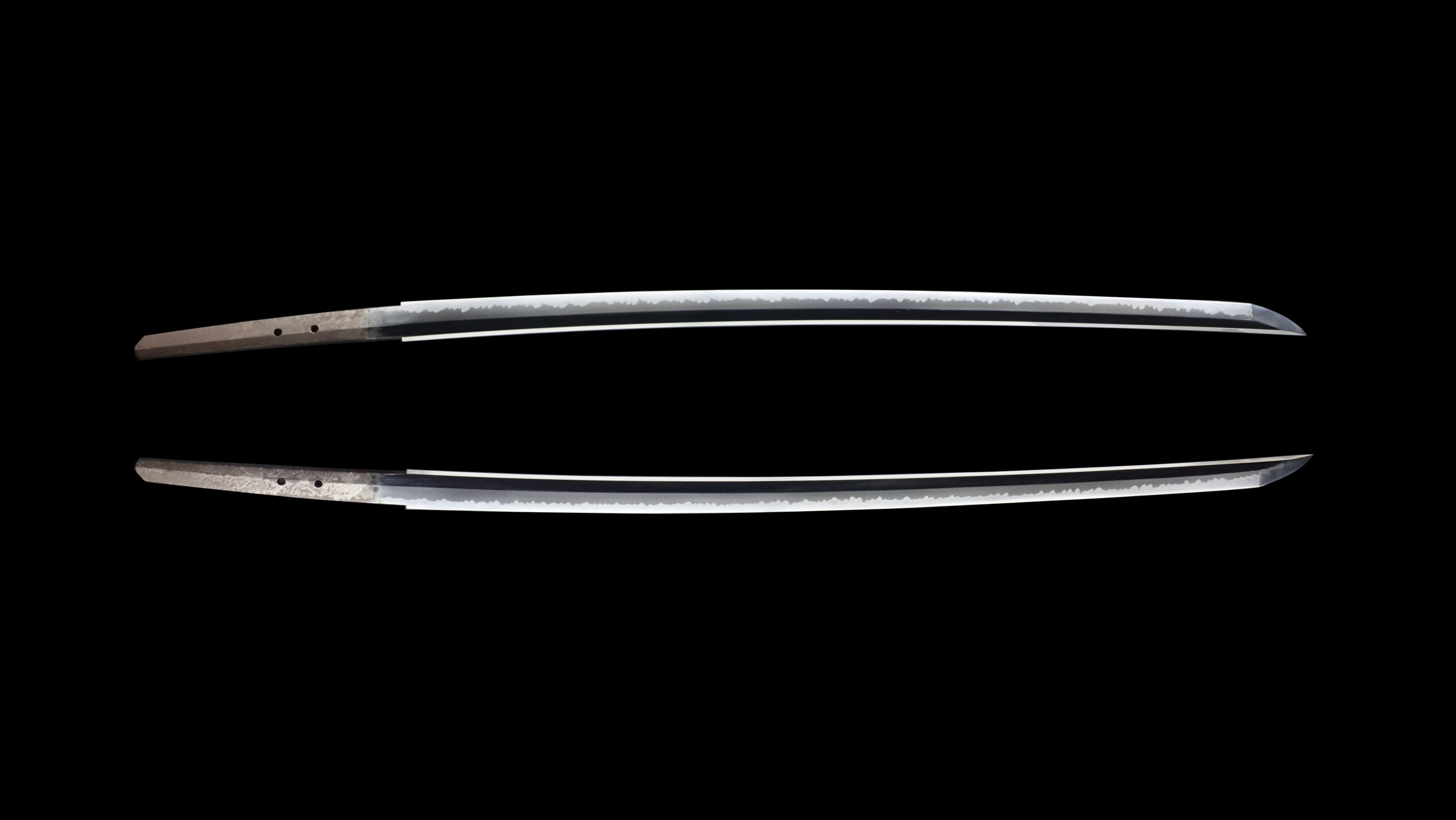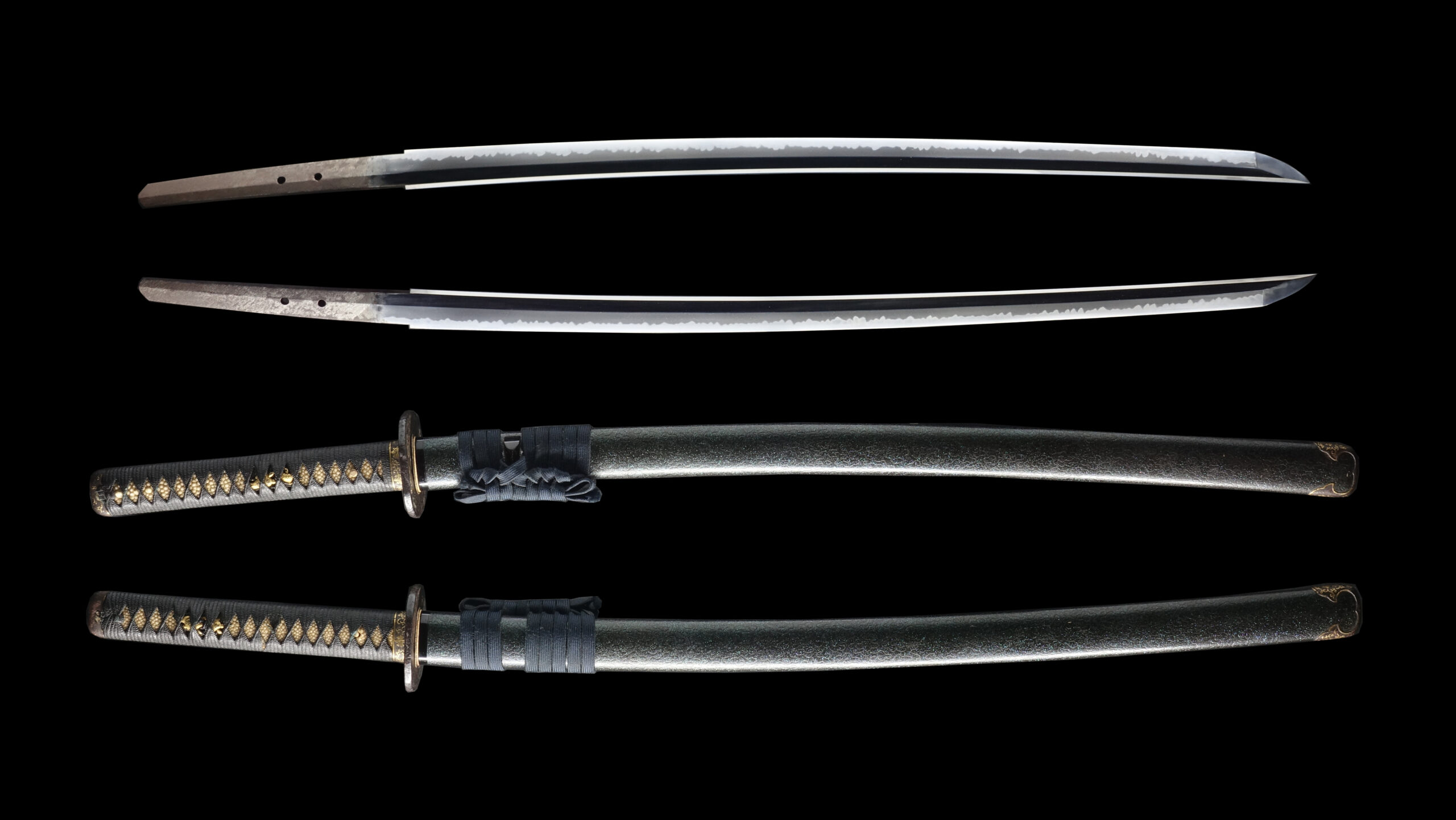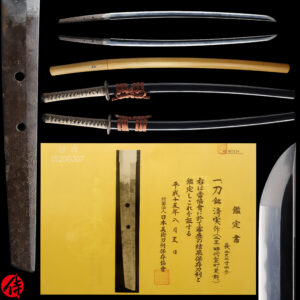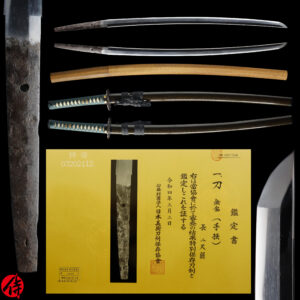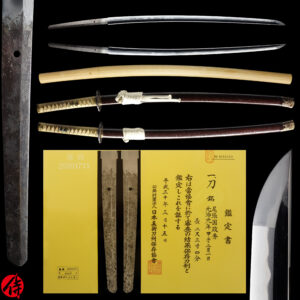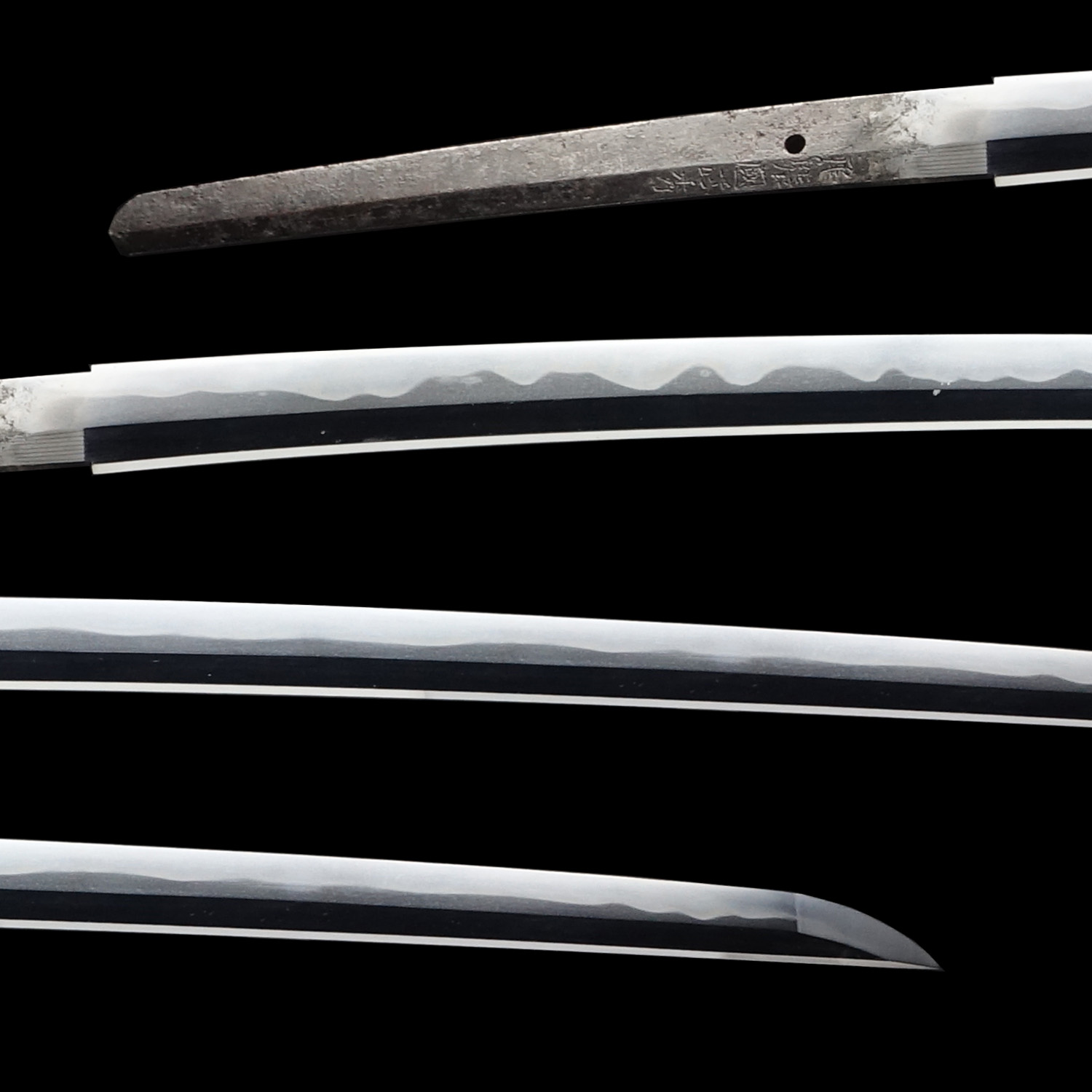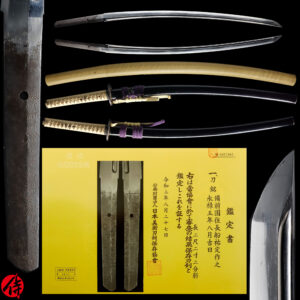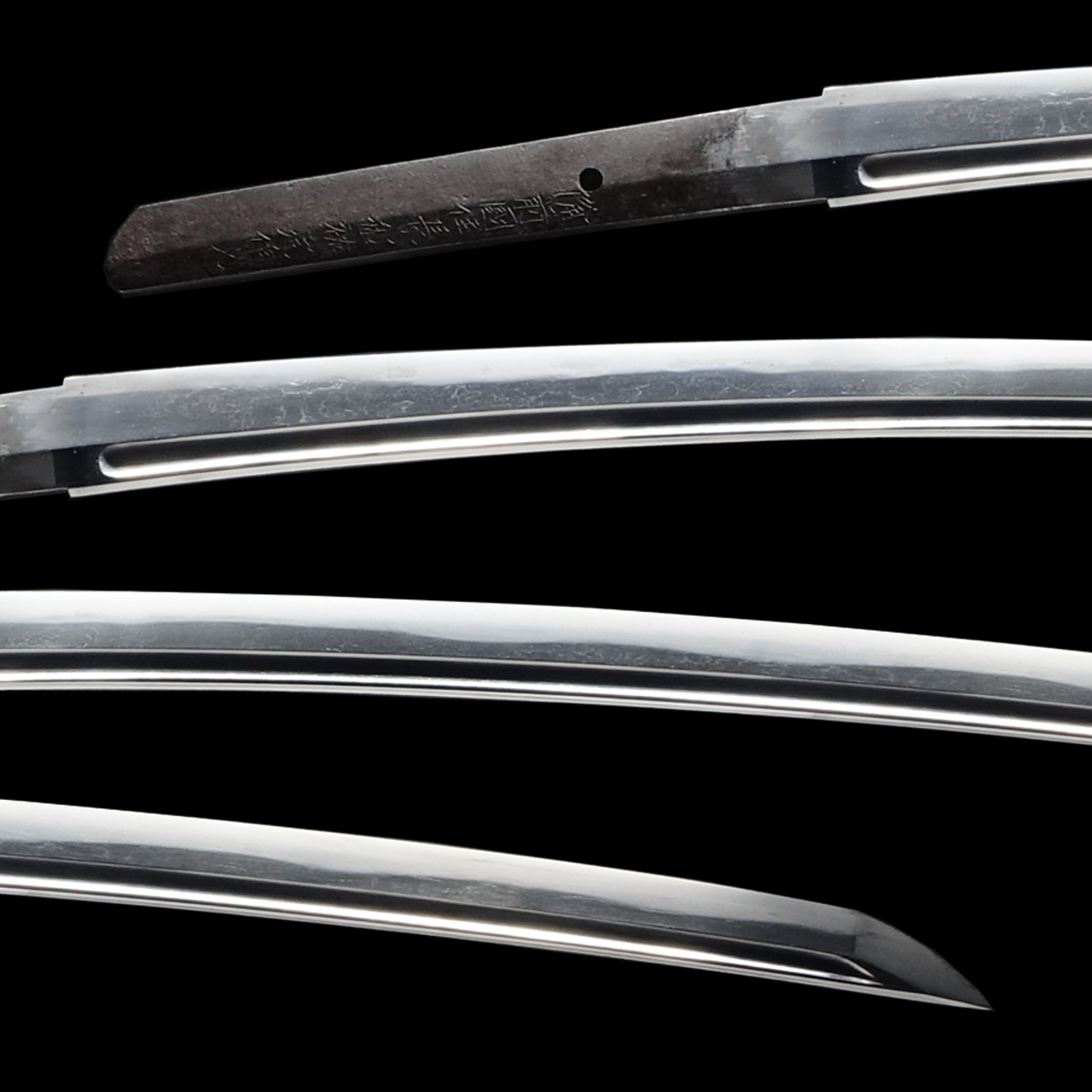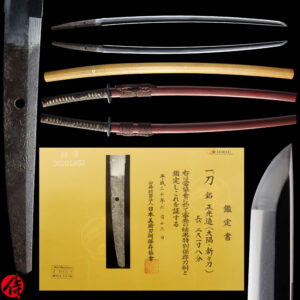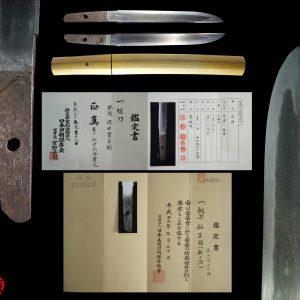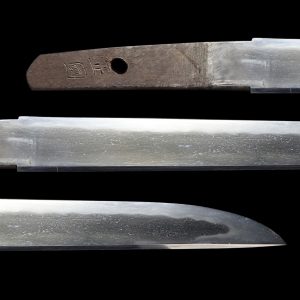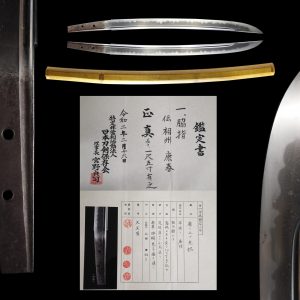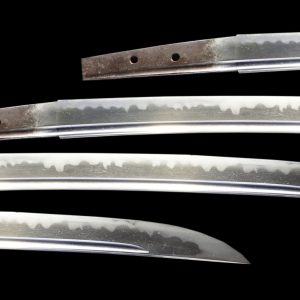Antique Japanese Sword Katana attributed to Koyama Munehira with NBTHK Hozon Certificate
【Description】
This blade is attributed to Koyama Munehira (固山宗平), who was active at the end of the Edo period. (Mid-Late 19th century ). Munehira was the older brother of Koyama Munetsugu, one of the most famous swordsmiths during the late Edo period.
Munehira initially forged blades in Shirakawa domain, located in Mutsu province (today’s Fukushima prefecture), and served Shirakawa Matsudaira clan. When the clan was relocated to Kuwana domain in today’s Mie prefecture, Munehira also moved there. In the 7th year of the Tenpo era (1836), he was hired by Doi family, who controlled Shimofusa Koga domain in today’s Chiba prefecture.
There was also a record of him going to Edo city with his younger brother, Munetsugu, to become an apprentice of Chounsai Tsunatoshi.
Munehira was excellent at forging blades with Choji Gunome Midare tempering line, one of the most noticeable characteristics of Bizen DEN Tradition. Bizen DEN is one of the five famous Japanese sword-forging traditions.
Based on available records, Munehira and Munetsugu closely worked together, living in the same domain for many years. We assume they improved their craftsmanship, encouraging each other.
Considering that Munehira was hired by two domains, we believe his sword-forging technique was highly appreciated among Samurai who lived there. Also, it is easily assumed that he always looked for room for improvement because he went to Edo city to learn craftsmanship from Chounsai Tsunatoshi, one of the most famous swordsmiths in Edo during the end of the Edo period.
This blade is appraised as a Hozon Touken (保存刀剣) issued by NBTHK (Nihon Bijutsu Touken Hozon Kyokai: 日本美術刀剣保存協会). This authentication paper was only given to authentic Japanese swords, well preserved and high quality with artistic value.
【Blade】
Cutting Edge Length (Nagasa): 67.7 cm (26.7 inches)
Curvature (Sori): 1.2 cm (0.47 inches)

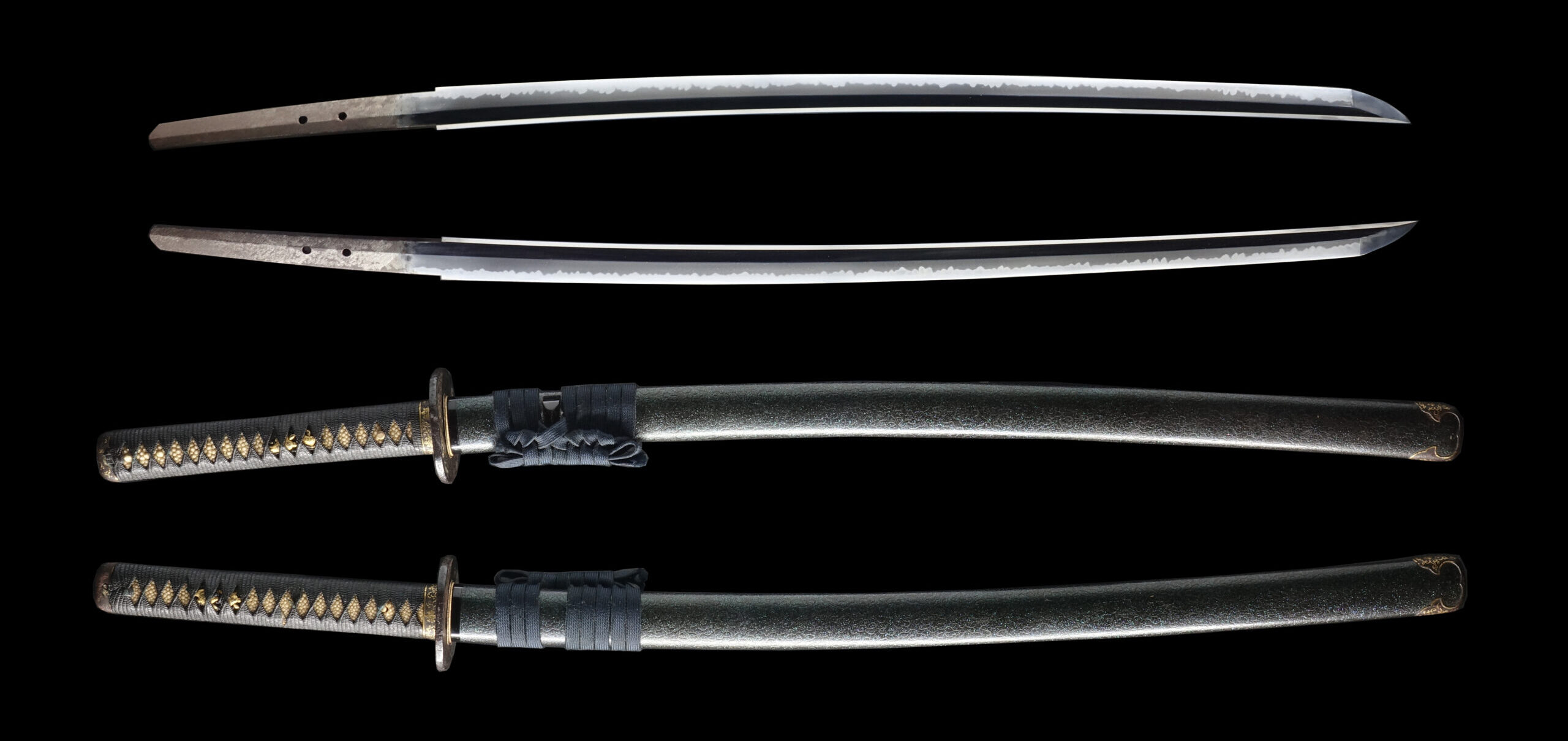
Hamon:
The crystalline structure which forms along the cutting edge of a blade as a result of the hardening process.
Jimon (Jihada):
Visible steel surface pattern created by folding and hammering during forging process.
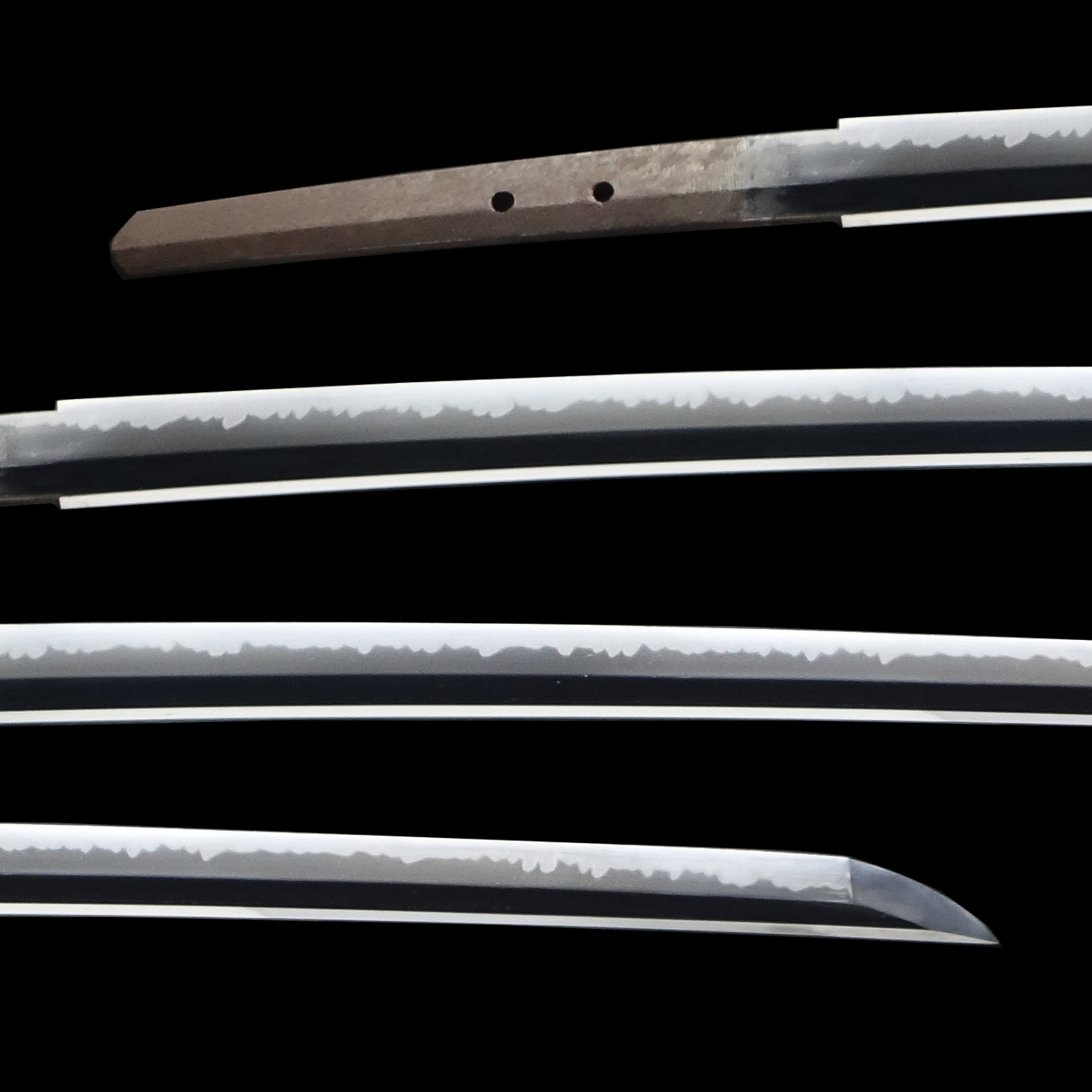





Nakago: Nakago is the tang of the Japanese sword.
Japanese swordsmiths left the black rust on the tang because it prevents red rust while the tang is in its handle. And the discoloration of the tang was created over time, and it is a great indicator for a Japanese sword specialist to estimate when the sword was forged.
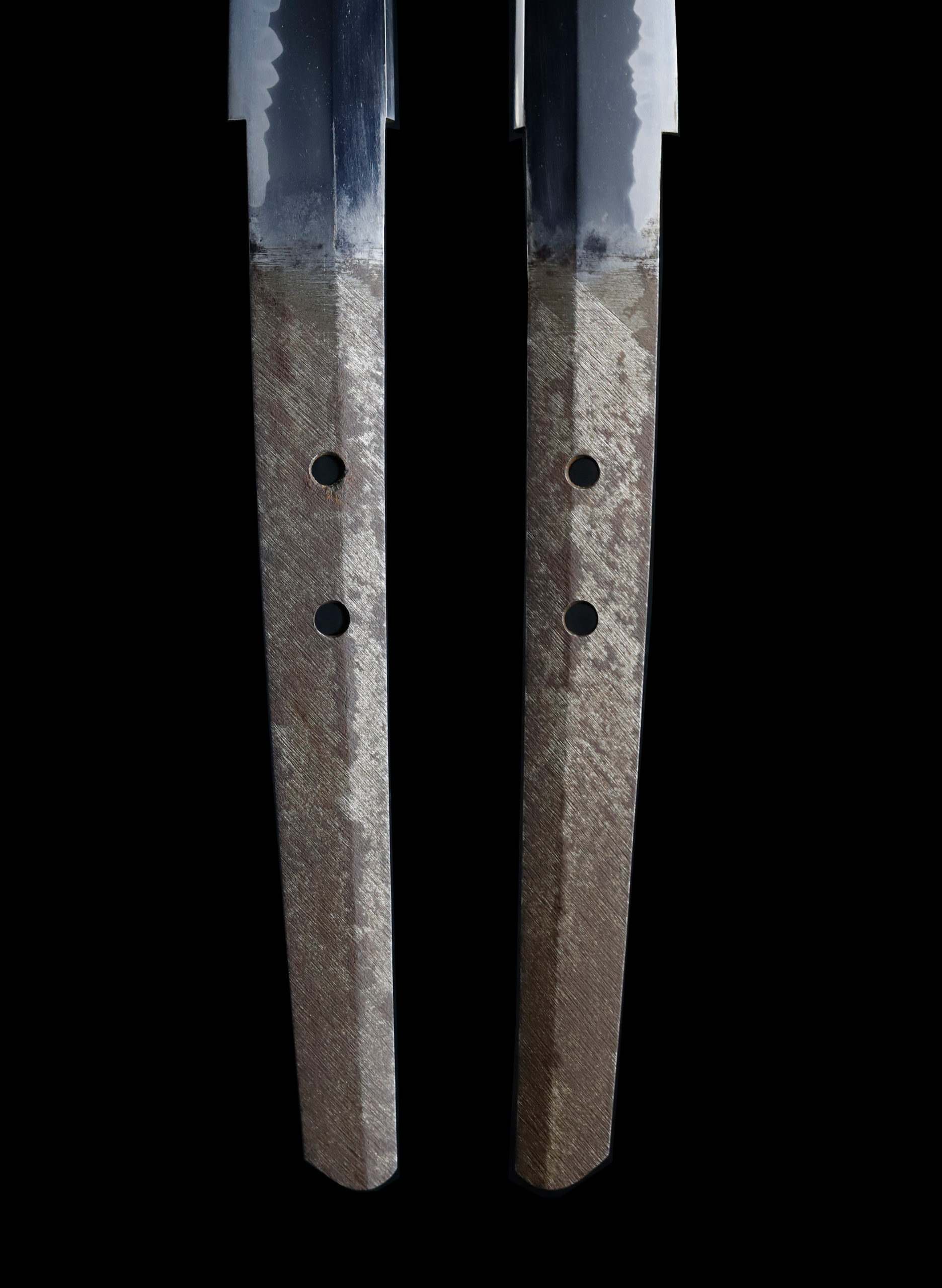
Koshirae: Koshirae is the mounting of the Japanese sword. There are several parts that consist of Koshirae such as Saya (Scabbard), Tsuka (Handle), Tsuba (Handguard).

Fuchi-Kashira: A pair of matching sword fittings that cover the upper and bottom parts of its sword hilt.
The Kiri Karakusa (桐唐草) pattern is designed on this Fuchi Kashira. Golden coloring (estimated brass inlay) is applied to it, making an ornamental look to this work. This design is a combination of the Kiri (桐, paulownia) and the Karakusa (唐草, arabesque).
The Kiri pattern is generally composed of three standing straight inflorescences and three leaves. The number of blooming flowers at each inflorescence means the ranks of this design. As seen on this Fuchi Kashira, the Gosan-no-Kiri (五三の桐) pattern is a popular design that the paulownia motif is used. This pattern was once used by the imperial family and people in authority back then. Today, it is permitted to use by ordinary households and is appreciated as their family crests. According to a tradition, the Houou (鳳凰, Fenghuang, a kind of sacred beast) rests its wings at the paulownia tree; therefore, it has come to be regarded as a holy plant.
The Karakusa pattern is a design in which stems and leaves of vines are twined and make curves. Since ivy has a strong vitality and grows up without interruption, people regarded this design as a symbol of prosperity and longevity. In this way, this Fuchi Kashira is decorated with such auspicious motifs.

Tsuka and Menuki: Tsuka is the handle of the Japanese sword and Menuki is its decoration.
Turtles are the motifs of this Menuki. Although some colorings have faded due to aging, its gold-colored painting adds decorativeness to this work. You would see the figures of two turtles on each Menuki from the gaps of the Tsukamaki thread. The turtles are carefully sculpted with attention to detail, from the turtles’ shell patterns on their shells to the flowing hair on their tails and facial expressions.
The Kikkou pattern is the design that depicts a turtle’s shell patterns. It is a continuous geometric pattern connecting regular hexagons up and down. According to a theory, this design was brought from China and the Korean Peninsula in the Asuka (592-710), and Nara periods (710-794). At that time in the continent, policymaking and decision-making were actively carried out by “Kiboku (亀ト),” which used turtles’ shells for fortune-telling. A shell was baked for a long time until its surface cracked, and people judged good or bad based on the direction and shape of the cracks. For these reasons, even after the Kikkou pattern was introduced to Japan, it was treated with high prestige as a sacred pattern. And it was monopolized by the aristocracy so that ordinary people even could not see it when this design was brought to Japan. It was such a prestigious design at that time.
A proverb says turtles live long lives, so the Kikkou pattern represents longevity. In addition, as this continuous hexagonal pattern does not get out of its shape, it is said people wished for eternal prosperity by using this design. Samurai started using the Kikkou pattern in the Kamakura period (1185-1333), and it became widely known among the general public around this time. The Kikkou pattern was incorporated into various items such as Kimono (着物, traditional Japanese costume), Obi (帯, belt for Kimono), porcelains, etcetera.
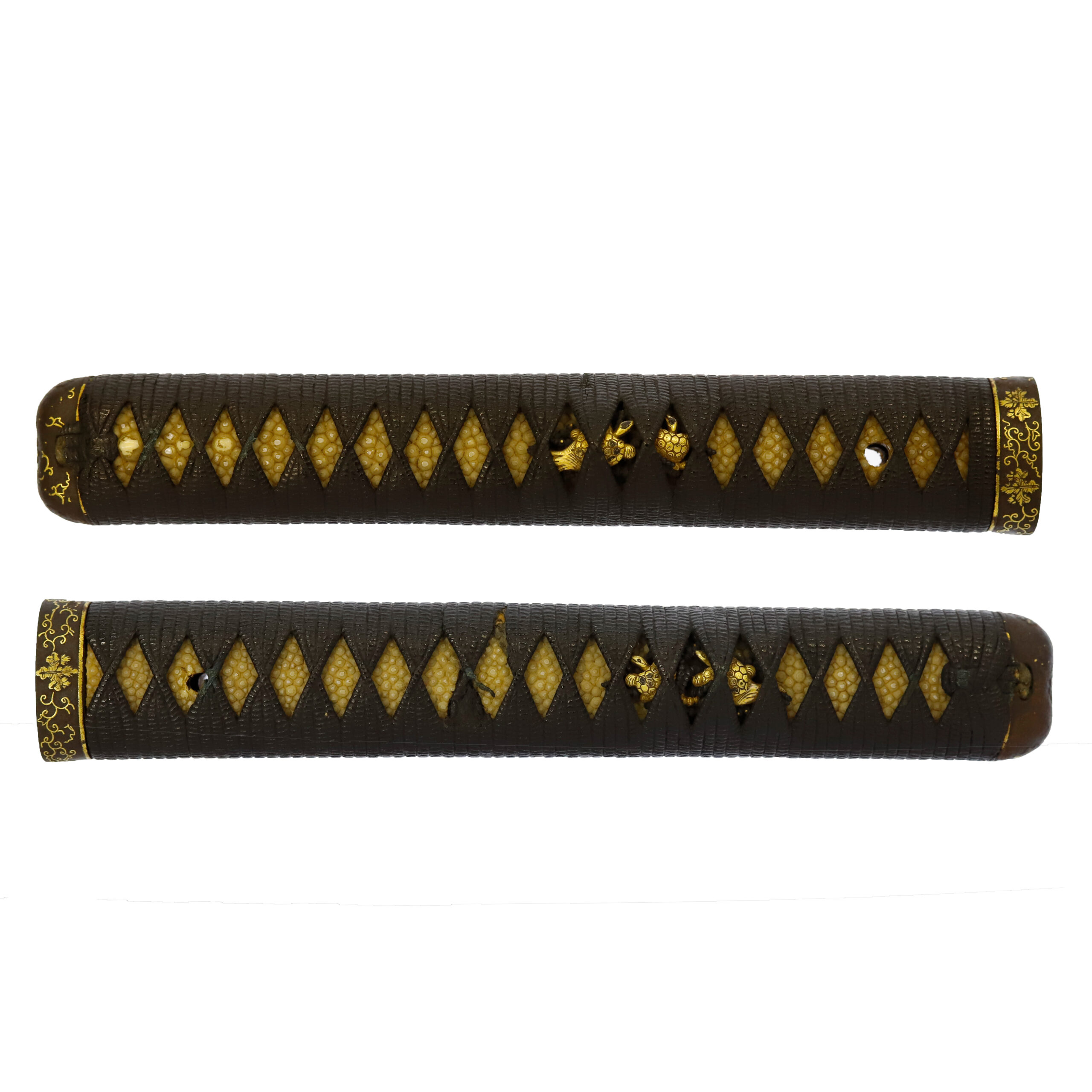
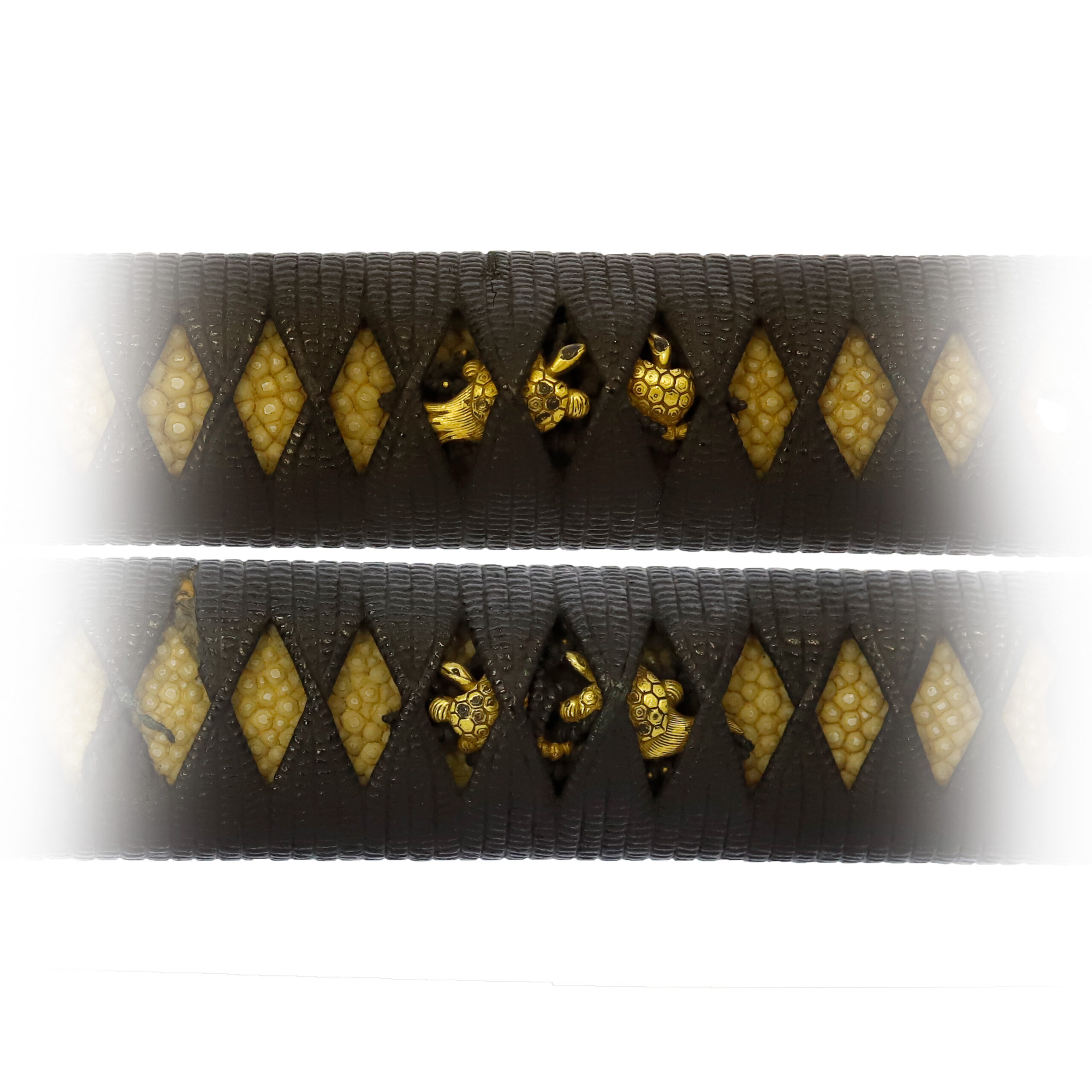
Tsuba and Habaki: Tsuba is the handguard for the Japanese Sword and Habaki is the equipment to make the blade not touch its scabbard inside. It prevents the blade from getting rusty and chipped.
A dragon is engraved on this Tsuba. It has a dignified facial expression and seems it is staring at information with a stern look. The surface of this Tsuba is uneven, and combined with the rough impression of the dragon, it creates a powerful atmosphere. You might feel that it is quite different from the designs of the sword mountings mentioned above (Fuchi Kashira and Menuki); the dragon is also one of the motifs of auspicious design. Initially, the dragon was an imaginary creature found in ancient foreign traditions or myths. In addition, it is regarded as a symbolic beast of auspicious signs. Its body is likened to nine animals: antlers are deer, the head is a camel, eyes are demons, the neck is a snake, the belly is the Mizuchi (蛟, a mythical animal in Japan that looks like a snake and has a horn and four legs), scales are fish, claws are falcons, palms are tigers, and ears are cows. It was thought that a dragon would reign at the top of all animals because of its odd-looking appearance. There are lots of dragon-designed sword mountings. It shows that many Samurai favored this sacred beast motif.
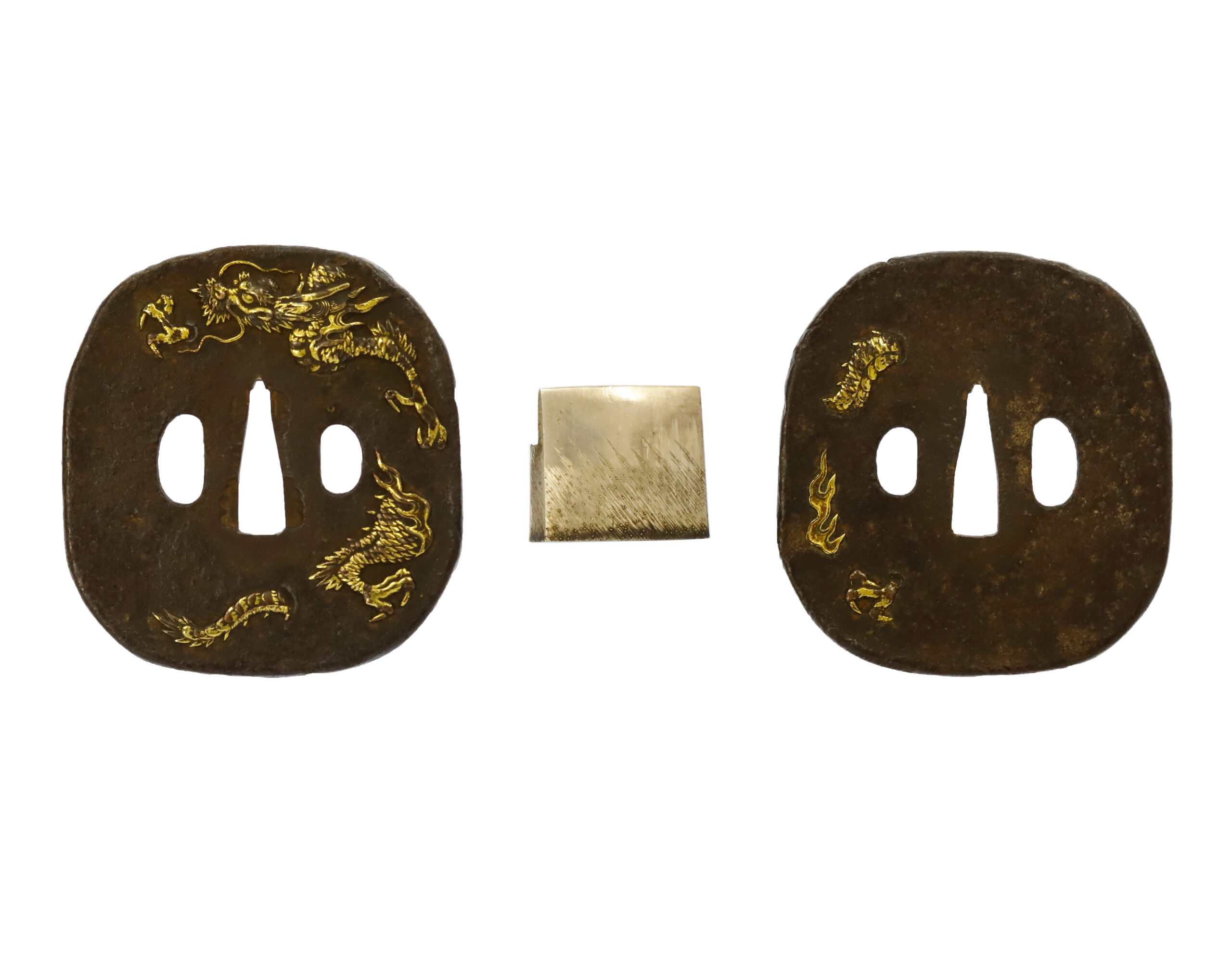
Saya: Saya is the scabbard for the Japanese sword.
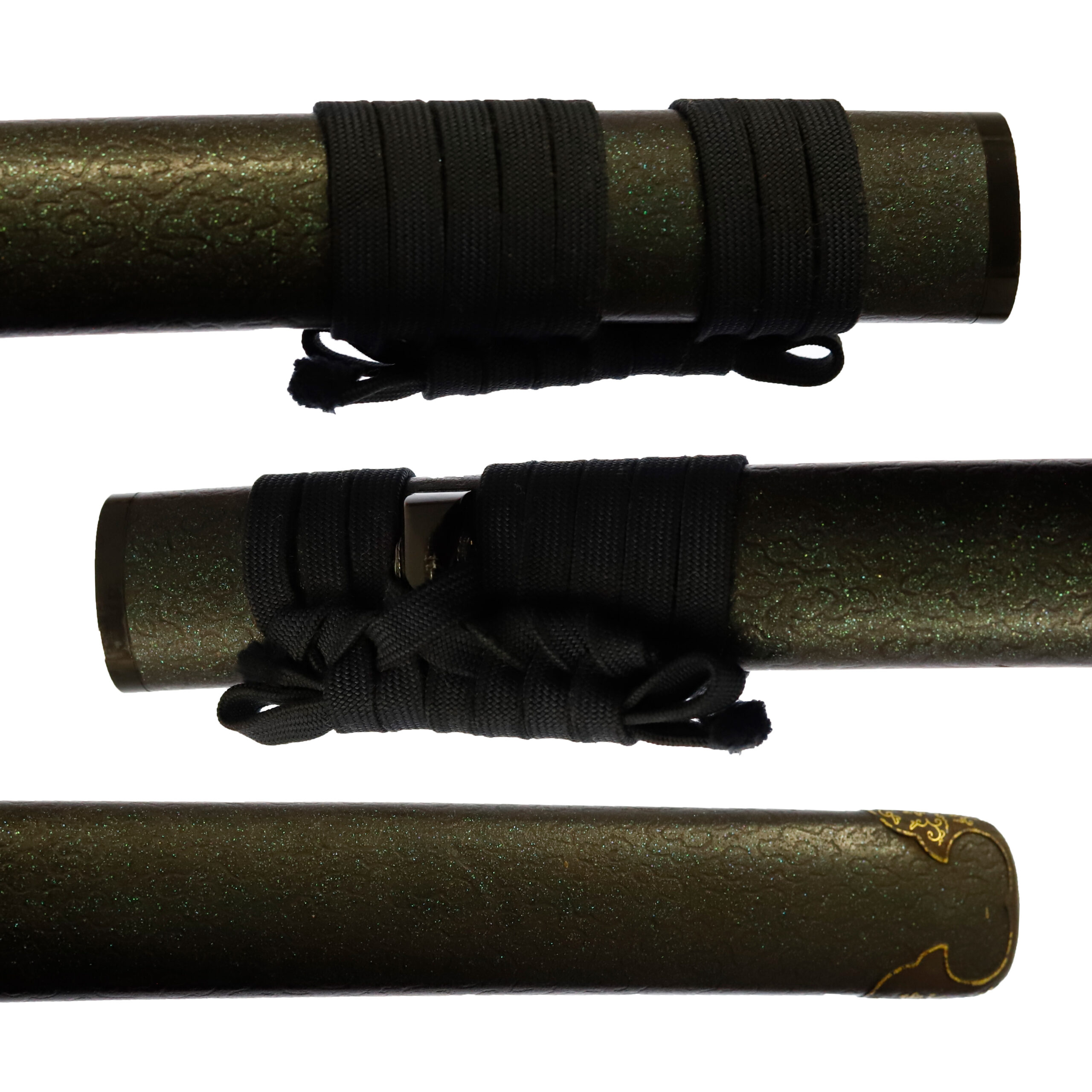
Authentication Paper: NBTHK Hozon Certificate for the blade (No.3029506)
NBTHK, also known as Nihon Bijutsu Touken Hozon Kyokai (the Society for the Preservation of the Japan Art Sword), is one of the oldest Japanese sword appraising organizations in modern-day Japan. They authenticated the blade on Aug. 25th in the 4th year of Reiwa (2022). They appraised it as Hozon Touken, the blade worth preserving for Japanese society. The purchaser will receive this original certificate as well. We can also translate what is written into English and make a PDF file for your record if you request.
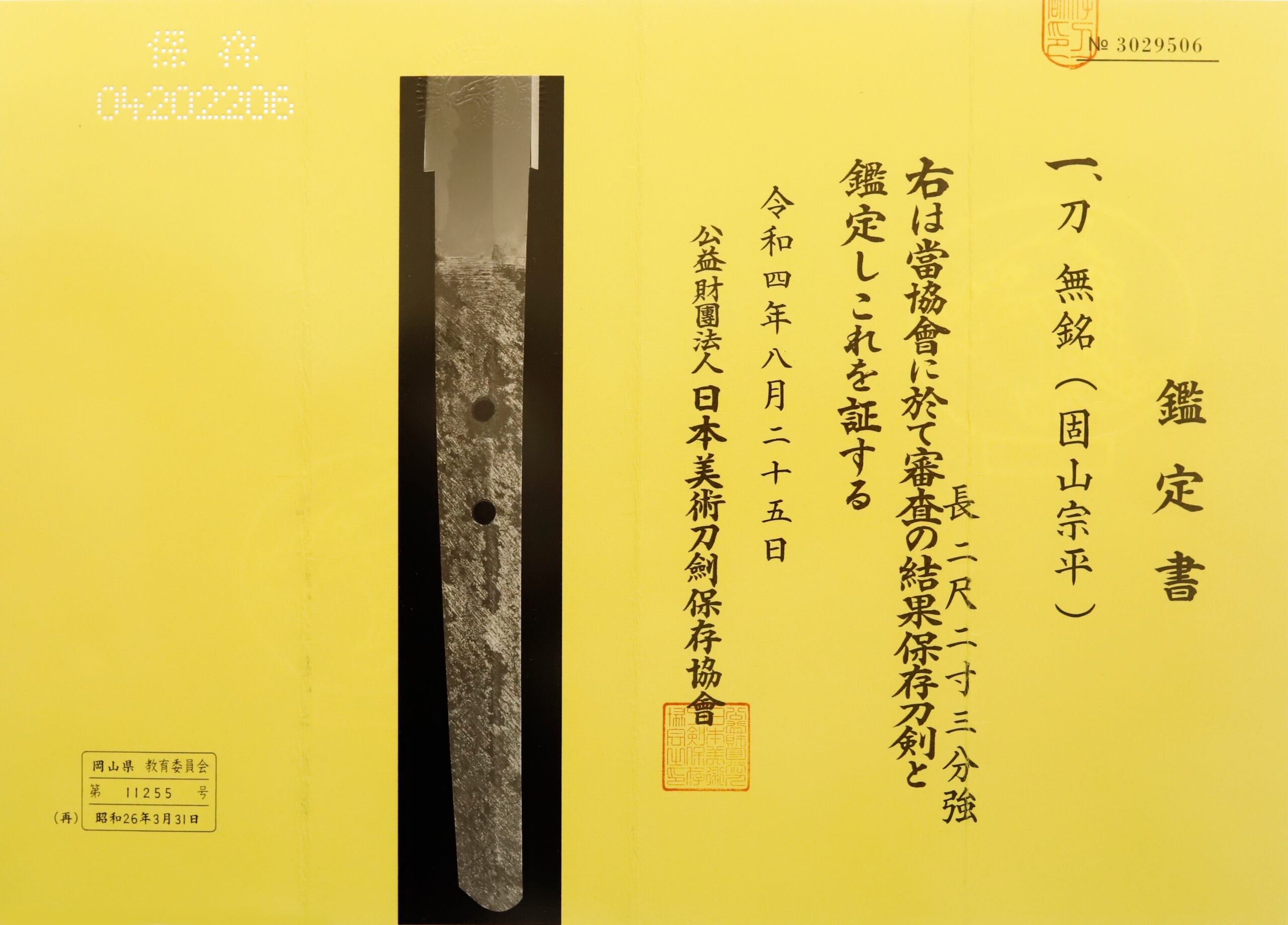
Registration Number: Okayama 11255
The Board of Education in Okayama prefecture issued a registration paper for this sword. It is called Jyu Token Rui Torokusho (銃刀剣類登録証). Bunkacho (The Agency for Cultural Affairs) acknowledges a Japanese sword with this paper as a work of art.
The sword needs to be traditionally hand-forged and made of Tamahagane carbon steel to be registered in the system. With this paper, its owner in Japan can legally own an authentic Japanese sword. Based on this registration number, we will apply for its export permit.
This paper will need to be returned to the board of education when the sword is being shipped abroad, but you can receive a copy of it. An English translation of this registration paper is available on request.


【About us】
Samurai Museum is located in Tokyo, Japan, exhibiting antique artifacts related to the Samurai history. Samurai Museum Shop is the place for those who are interested in Japanese culture and craftsmanship. We deal with antique Samurai swords/armor, traditional crafts made in Japan and so on.
【Review】
Here is one of the reviews we received from a customer who purchased an authentic Japanese sword from us. For more reviews, please click here.
“My experience overall with the whole process was wonderful. I had many questions about the history and process to purchase these treasures. All my questions were answered very timely and complete. The staff is very knowledgeable and very well versed if any questions do arise.”
【Japanese Sword& Export Process】
The Japanese swords we deal with are hand-forged edged swords made in Japan. It was made from the traditional carbon steel called TAMAHAGANE (玉鋼). Samurai Museum is familiar with the proper legal procedure for an antique/ authentic Japanese sword to be exported from Japan. We have sent more than 500 Japanese swords for the past three years (~2023) to amazing owners who appreciate its historical value.
Each Japanese sword is registered under the Agency for Cultural Affairs and the Board of Education in Japan. They issue a registration paper for each Japanese sword for its owner in Japan to legally possess it. The Japanese sword with its registration paper means it was traditionally hand-forged in Japan.
To legally export the sword from Japan to other countries, we will have to apply for its permit to the Agency for Cultural Affairs (Bunkacho) and return the original registration paper to the Board of Education. It normally takes around 2-4 weeks to receive this permit after submitting required documents. And we would like you to expect at least 1-1.5 months for your order to arrive at your given address after you ordered. For more detailed info, please click here.
It is allowed for residents in Japan to own authentic Japanese swords without a special license as long as they come with registration papers. Please feel free to contact us if you are a resident of Japan, whether temporarily or permanently. We will also assist you when you leave Japan and need to obtain the export permit.
【Payment Method】
We accept payment through Stripe (Credit card), PayPal, Apple Pay or ChromePay, all of which are secure payment methods. Also, you don’t need to make an account on Stripe for the checkout. If you prefer other payment method, please contact us. After confirming your payment, we will apply for an export permit. You may either pay in JPY, USD, AUD, CAD, EUR, CHF or GBP. The price is set in Japanese Yen. Prices in other currencies are automatically calculated based on the latest exchange rate.

*If the amount is above 1 million JPY, Stripe or wire transfer will be the only options for payment.
【Shipping】
We have shipped authentic Japanese swords to the USA, UK, Canada, Mexico, Germany, France, Hong Kong and Australia. If you don’t live in these countries and like to order, please contact us first before making a purchase. We offer Free International Shipping as long as we can send antique Japanese swords by EMS.
We normally ship by EMS (Express Mail Service) provided by Japan Post. We will send you a tracking number for your order as soon as we hand it to the post office. We will put 100 % insurance on the shipping document without any extra charge. Based on the total amount, there might be a duty tax or other fee for you to pay, depending on the countries. We use package cushioning to protect the item and put it in a PVC pipe, which is one of the most secure packages because of its durability.
It will normally take 5-14 days for the item to arrive at your given address after we dispatch it. Time of delivery is estimated as accurately as possible by the carrier but does not take into account any delays beyond our control such as by inclement weather, post office holiday seasons.
*If you live in Australia and like to purchase an authentic Japanese sword, please click here to know the detail.
*Please keep in mind that due to the spread of COVID-19, there might be delays in shipping. If you like to know the detail about shipping, please feel free to ask us.

【How to make sure the condition】
Please keep in mind that what you are going to purchase is an antique item. We uploaded high resolution photos for you to check its condition thoroughly. If you like to see more photos with different angles, please feel free to contact us. We will be happy to send them to you so that you can make informed decision. It is essential for us to know that you are happy with your choice of a sword. and we are prepared to use the best of our ability to serve you.
【How To Contact Us】
Please contact us through email, Facebook Messenger or Live Chat if you have any questions. You can find each icon on the right side of the website. Please click one of them to reach us. We will reply to you within 1-2 business days.
【The Art of Nihonto (Japanese Sword) 】
Samurai’s history is a profound, eloquent legacy of ancient Japanese warriors in which millions of people worldwide are being fascinated. If you like to find out the art of Nihonto, please click here.
【A Guide to Japanese Sword Maintenance】
After acquiring a genuine Japanese sword, it is also important to know how to take good care of it. Here is the special video for you. Mr. Paul Martin, Japanese sword expert, shows you how to give proper maintenance to your sword. By mastering how to clean the Japanese sword, its aesthetic beauty will last forever.
When you purchase a Japanese sword from us, you can get a Free Japanese sword maintenance kit. It comes with four tools (Choji Oil, Uchiko Whetstone Powder, Peg remover, Oil Applicator). By watching the video instruction above, you can enjoy learning how to maintain your Japanese sword while appreciating it. If you have any difficulty assembling the sword or cleaning the blade, you can feel free to contact us.


MORE ANTIQUE JAPANESE SWORD FOR SALE
SWORDS WITHOUT CERTIFICATES FOR SALE
LEARN JAPANESE SWORD TERMINOLOGY
Thank you for reading all the information on the page. If you have any difficulty choosing the right Japanese sword for you, we will be more than happy to help you find the one that speaks to you the most. Please feel free to contact us.


